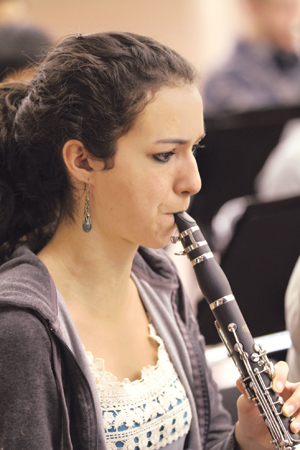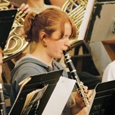 Over many years of playing and teaching clarinet, I have come across a few helpful techniques and tricks.
Over many years of playing and teaching clarinet, I have come across a few helpful techniques and tricks.
Technique
To form the embouchure, tuck a small amount of the center or tip of the upper lip under itself on the mouthpiece, but not under the teeth. The upper lip should produce a clean line where it sits on the mouthpiece.
Whistle Bb4 to identify the best tongue position for slurs within the staff.
Learn to change from the clarion register to altissimo smoothly. A good way to practice is by playing a high note to find the altissimo embouchure. Then without moving anything, play a passage that begins in the middle register and shifts to the altissimo register.
A good way to find the correct pressure on the reed is to play on the mouthpiece and reed while using a tuner. The correct amount of pressure should produce a concert C that is a bit sharp. If it produces a concert B, the embouchure is too loose, the reed is too soft, or too little breath is used to support the tone. These are the same problems that make high notes difficult to play and cause pitches to be flat. If the mouthpiece and reed produce a C# or D, then too much pressure is used and the instrument will sound sharp.
Move only the first half inch of the tip of the tongue to articulate. The tongue should form the shape used to produce the French vowel sound eu. This gives the tongue a solid form, as if it had a spine. To tongue on the reed with varying degrees of pressure, change between the syllables tee, dee, and lee.
Clarinetists should practice tonguing using just the mouthpiece and barrel with a tuner. If the pitch goes more than five cents flat during articulations, the jaw is probably moving with the tongue.
Pitches tend to go sharp at a soft volume; watch the intonation during diminuendos. Soft passages require the same air pressure as loud passages, although the volume of air is smaller for soft playing. A crescendo requires increasing air pressure instead of loosening the embouchure. Think of blowing from the abdominal muscles through to the bell and slightly beyond.
Instead of sliding or rocking the left thumb off the thumb hole, it should move out and away from the hole as the other fingers do. Practice this exercise and focus on the thumb movement.

When playing softly from C5 to Bb5, lift the middle finger of the left hand for the Bb5 to create the fingering of Thumb-Register-1-3, (Right hand) 1-2-3-C key in the pinky.
To trill from G5 to A5, finger the G and trill the side Bb/Eb key in the right hand for the A.
Students should practice playing legato while standing, which tends to open the airway. Sitting leads to poor posture and tension, especially during long practice sessions. Poor posture, especially in the lower back, collapses the rib cage and lungs onto the abdominal muscles and impedes the smooth airstream required to play legato.
For smooth legato playing, the fingers should cover the tone holes squarely and without a popping sound. When a note change entails moving two or more fingers, squeeze the fingers before lifting them. If an interval involves lifting many fingers, such as from C5 to C6, push the right thumb up a bit toward the embouchure to set the mouthpiece or the second note will pop out with an accent. The right hand should maintain an arch shape at all times.
Musicianship
Always exaggerate dynamics because what players hear while holding the horn may not be what the audience hears several yards away. As beginning band directors often say, play to the back of the room so the people farthest away can hear without straining.
Staccato notes should normally be short and light but students often accent these too heavily. The tone should sound the same for staccato passages as for slow ones. Too often players only think about making the notes short and forget the importance of a good sound.
When playing dotted eighth-sixteenth notes, hold the dotted eighth for full value. A common mistake is to play it as an eighth note followed by a sixteenth rest before the sixteenth note.
Dotted eighth-sixteenth note figures adjacent to eighth note triplets should be exaggerated to a double dotted eighth-thirty second to clearly distinguish it from the triplets. Otherwise the dotted eighth-sixteenth notes may become lazy and sound like quarter note-eighth note triplets.
Accent upbeat figures slightly to bring out the syncopation.
Avoid accenting grace notes that come before the beat and notes on the downbeat unless an accent is written. However, sometimes emphasizing the bottom note of a fast arpeggio makes it easier to spring through the run.
The second note in a pair of repeated notes should be slightly louder than the first.
Avoid pulsing the air on downbeats during long notes and creating breath accents.
When playing a rising half-step at a cadence, accent the leading tone slightly. Also avoid key noise at the ends of phrases.
Play phrases to sound as though they are moving toward a high point or conclusion. I refer to this as kinetic phrasing. Long notes within a phrase should have some subtle combination of crescendo and diminuendo or vibrato to maintain the energy. An exception is that it can be effective to sit on a long note at the high point of a phrase to show that the peak has been reached.
Players should be confident enough with their technique that it does not interfere with making music. Technical skill is no substitute for good musicianship; even phrases that entail advanced technique should be playedexpressively.





